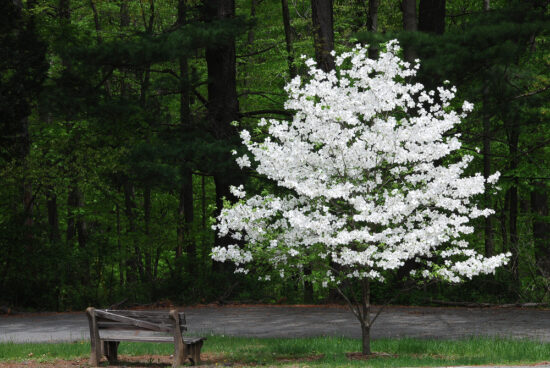
As a landscape designer, I find people are often surprised when I bring up dogwood shrubs. This isn’t because they aren’t beautiful – on the contrary. But rather that many people are unaware that the dogwood family includes not just woody trees, but also a group of flowering shrubs with stunning attributes. Expanding your dogwood repertoire, in fact, can add not just spring, but all year interest to a home garden.
Below are a few popular species guaranteed to light up your landscape.
SPRING AWAKENING, THE AMERICAN DOGWOOD

American dogwood blooms before the leaves
In the eastern United States, spring wouldn’t be spring without the magnificent American dogwood, Cornus florida. Blooming in late April, this small, deciduous tree produces a profusion of petal-like bracts in shades of creamy white, pink and nearly red. The “flowers”, which appear before the leaves, are followed by bright red fruit known as drupe. In fall, the foliage turns a deep maroon.
In the late 1970s, many American dogwoods were stricken by anthracnose, a fungal disease that causes tan blotchy leaf spots and eventual death of infected leaves and twigs. Today’s hybrids, however, exhibit great disease resistance.
Some of my favorites are: Cherokee Brave with its deep pink flowers and white centers, the large-flowered Cherokee Princess, and the white-flowering, slightly scented Fragrant Cloud.
Fun fact: You can identify an American dogwood in the winter by its turban-shaped end buds.
ASIAN INFLUENCE, THE KOUSA DOGWOOD

Kousa dogwood blooms above the leaves
Also known as Chinese or Japanese dogwood, Kousa dogwood (Cornus kousa), produces a brilliant array of star-like white petals in late spring above its foliage. Its bloom period follows the American dogwood, making it a great seque into summer. In summer, its layered branches hang heavy with dark green leaves that turn purple to red in fall. And in winter, the tree’s sculptural, multi-branched form adds interest, as does its exfoliating bark that turns mottled tan and grey over time.
Some great varieties to try: Temple Jewel (also called Satomi) has variegated lime green and gold leaves and white flowers, Welchii produces variegated green, cream white and pink leaves, Stellar Pink produces massive displays of light pink flowers, and the smaller-size Wolf Eyes is a white-flowering cultivar with narrow, variegated light green and white leaves.
HORIZONTAL BEAUTY, THE PAGODA DOGWOOD

Unusual flowers and horizontal branching make Pagoda a stand-out
In contrast to the American and Japanese dogwoods’ rounded shapes, the Pagoda dogwood, Cornus alternifolia, has layered branches and a flat crown that resemble a pagoda. Multi-stemmed, this deciduous shrub eventually develops into a small tree with proper pruning. A stunning variegated-leaved variety is Argentea.
MELLOW YELLOW, THE CORNELIAN CHERRY

Yellow flowers distinguish this dogwood variety
Not to be confused with the cherry species, Cornus mas is a large shrub or small tree that is one of the earliest woody plants to flower. Instead of white or pink flowers, however, it produces yellow blooms in early spring before the leaves appear. The fruits, which turn cherry red in mid-summer are edible. In fact, you can use them to make liquors, jams, desserts and sauces. Unlike other cultivars, however, the Cornelian cherry’s fall color is not very showy.
ALL FIRED UP, THE RED TWIG DOGWOOD

Full sun turns red twig dogwood branches scarlet
The medium-sized deciduous shrub red twig dogwood, Cornus sericea, Cornus stolonifera or Cornus alba, was made for winter. Also known as red osier dogwood, its stems start turning red at the end of the summer, gradually brightening until becoming scarlet red in winter. The stems return to green in the spring.
Red twig dogwood can bear either dark green or variegated leaves depending on the variety. The foliage turns various shades of red or orange in the fall. The red bark, however, is not fully visible until the leaves have fallen. This is a big shrub, so give it plenty of room to grow. When stems come into contact with the ground they root, making it a great hedgerow or screen plant.
Check out C. alba ‘Argenteo-Marginata’ for it green leaves with white edges or C. alba ‘Hessei’ with it deep green crinkled leaves and dark purple fall color.
LEGGY STAR, THE YELLOW TWIG DOGWOOD

Yellow twig dogwood
The multi-stemmed cultivar of the red twig dogwood, yellow twig dogwood has greenish yellow stems. The twigs and upper leaf surfaces sport silky hairs, hence the Latin name sericea, meaning silky.
During the spring and summer, yellow twig dogwoods produce dark green foliage over greenish-yellow stems, a nice background plant for a garden border. In late spring, clusters of creamy white flowers are followed by pinkish-white berries. But the fall is when these shrubs really shine, as their foliage turns reddish orange, and the stems take on a golden hue.
NORTHERN CHARM, THE CANADIAN BUNCHBERRY

Dogwood can be a ground cover, too!
Canadian bunchberry, Cornus canadensis, grows to just 6 to 12 inches. A part-shade lover, it grows by rhizomes and produces glossy, dark-green leaves with distinctive veining. In the late spring, bunchberry is covered with white flowers followed by red fruits in late summer, which are edible. In the fall, its leaves turn brilliant shades of red and purple.
Caring for Dogwoods
Though dogwoods require little to no maintenance, over time they may need some pruning to keep them in bounds, especially in smaller landscapes where the shrubs can become leggy and less attractive with age.
Dogwoods can thrive in sun or part shade, but to get the best color out of your dogwood shrubs branches, full sun works best.

